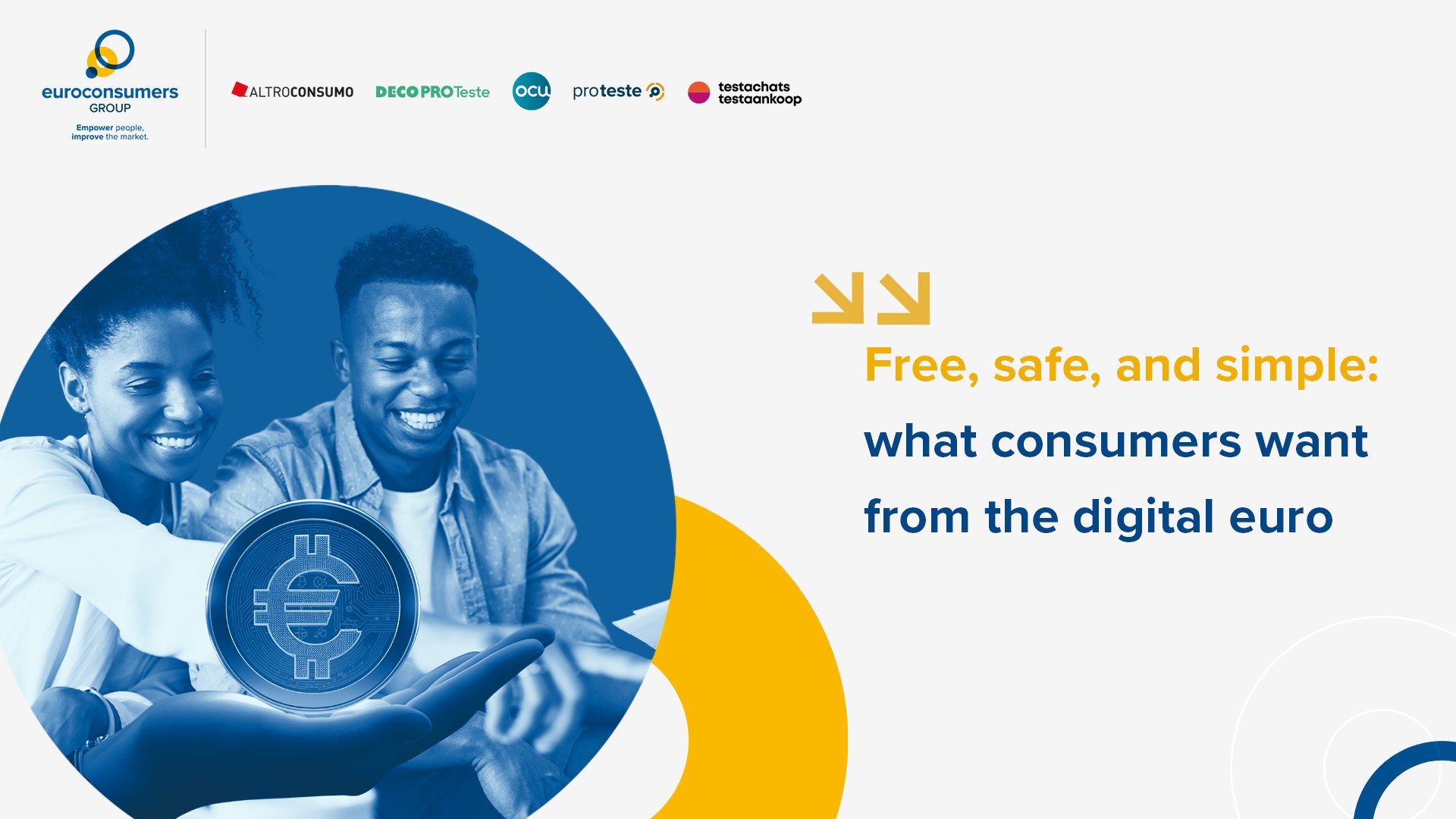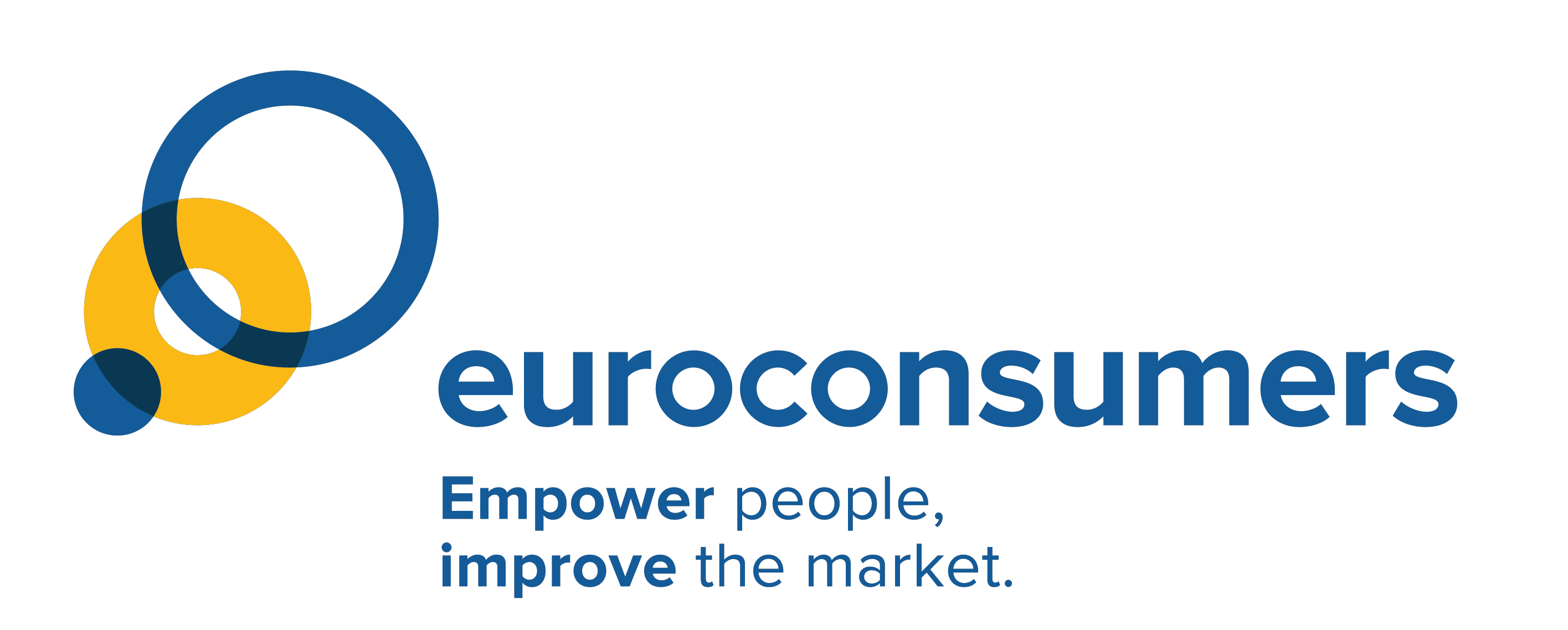Free, safe and simple: What consumers want from the digital euro

The proposed digital euro must earn consumer trust from the very start. Right now, as EU policymakers and the European Central Bank develop their plans for roll out, consumer insight is essential to understand people’s experiences, preferences and concerns with paying digitally.
A major new survey, a joint effort from BEUC, Euroconsumers, ICRT and thirteen European consumer organisations, brings in new perspectives on how to earn consumer trust and make this new innovation a success.
The study was carried out in parallel in 10 countries this summer and around 1,000 responses per country were collected and analysed by Euroconsumers. The full results from all ten eurozone countries can be found here. The rest of this blog focuses in on the findings from over 4,000 consumers in our Euroconsumers member countries of Belgium, Italy, Spain and Portugal.
The research also set out to understand what the next generation of digital consumers thinks, so we paid special attention to teens aged 14 to 17, a group whose views on digital payments have not yet been studied in depth.
What is the digital euro?
The proposed digital euro will be a digital currency issued by commercial banks and backed by the European Central Bank. It is designed for consumers to use alongside physical cash as an additional way to pay for things in shops, online or to send money to other people.
Like cash, it will be a Central Bank Digital Currency meaning people will have direct access to central bank money in digital format. Currently, most of the money consumers spend is from commercial banks, so this marks a significant shift in how everyday payments could work.
If designed well, the digital euro which replicates the key features of cash would give consumers access to new ways to pay and help build an inclusive digital payment method.
What do consumers want from the new digital euro?
1. Security and reliability top the list for digital payments
Among all features of digital payment systems, consumers rank security and reliability as the most critical.
Adult respondents in Belgium, Italy, Spain and Portugal ranked ease of use (59%) and safety (56%) as the most important aspects of digital payments. For teens the ranking is similar: 65% considered ease of use to be most important, and 48% said safety.
Security worries were top of mind for respondents of all ages, with most adults and teens expressing concern about falling victim to cyberattacks or online fraud and scams.
How many people were somewhat or very concerned about security risks with online payments?
82% of consumers aged 18-74
81% of consumers aged 14-17
And this is based on real life experience, as a significant portion of adults report being hit by scams or security issues linked to a digital payment. 23% of adults and 12% of teens who pay digitally report being victims of a security breach or fraud related to a digital payment in the last five years.
Consumer trust recommendation: features that make the digital euro should be easy to use and secure must be designed in from the start.
2. Ease of use with a preference for physical cards
Even though digital is often seen as the default for payments, many people still find it tricky to use. Well over half (62%) of teens from Belgium, Italy, Spain and Portugal who use digital payment methods had experienced difficulties – with the highest number (79%) in Italy. Problems ranged from technical errors to security concerns or lack of skills. For adults, the proportion was 55%.
- • Asking for help with digital payments is pretty common – nearly half of teens (49%) and over four in ten adults (43%) have assisted a friend or family member make a digital payment.
Given the potential glitches, it’s no surprise that when it comes to convenience, consumers rank physical cards as the most user-friendly option for making payments.
Consumer trust recommendation: the digital euro should include strong accessibility features to respond to existing complicated digital payment processes, serving its role as a public payment method by increasing inclusion and access in the payments landscape.
3. Digital payments at no cost to users
The research results showed that cost-free access will be essential for widespread adoption of digital payment systems. Across age groups and countries, most agreed that paying digitally should be free of charge, and that everyone should be able to access at least a basic bank account free of charge, and that payment cards should be offered at no extra cost.
- • 88% say every bank account should offer a free payment card.
- • 88% say paying digitally should be free for consumers
- • 85% say everyone should have free access to a basic bank account
Consumer trust recommendation: A digital euro card should be offered free of charge to meet consumers’ expectations, ensure broad adoption and accessibility, and basic digital euro services should be offered free of charge.
4. Refund protection against fraud and scams
Consumers place high value on getting refunds in cases of fraud or scams. If something goes wrong, people want to know they’ll get their money back.
A large majority of teens (88%) and adults (85%) believe digital payment providers should refund consumers if fraud or security violations happen, with higher levels of agreement in Spain and Portugal.
Consumer trust recommendation: The digital euro must ensure strong fraud prevention and protection – including easy refund procedures and reliable dispute resolution systems.
5. Data sharing for security but not for commercial profit
Consumers strongly value privacy in payments and 81% of adults and 78% of teens are at least somewhat concerned about privacy violations.
Almost half of teen users (45%) and adults (44%) who pay digitally are comfortable sharing personal data for fraud prevention and anti-money laundering checks. However, consumers are less willing to share their data for commercial purposes, especially as they get older.
Consumer trust recommendation: The digital euro should offer enhanced privacy compared to current methods (particularly offline for low-value and proximity payments) while keeping anti-money laundering and fraud checks in place for higher-risk transactions online.
6. Keep the cash
Despite digital payments, there is strong support for cash across generations. Just over half of adults (51%) are concerned about a future where they might lose the freedom to choose whether to pay by cash, cards or digital wallets. This fear is most pronounced in Spain, where 58% were concerned, compared to Belgium where 50% were.
Teens across Belgium, Spain and Portugal were a little less worried, with 42% expressing the fear of losing future payment options, but only 27% of teens in Italy shared this concern.
Overall, 83% of everyone surveyed thought that, in the long term, cash should continue to be accepted everywhere at no cost.
Consumer trust recommendation: Communication should clearly explain that the digital euro will complement, not replace, cash and existing payment options.
What do people know about the new digital euro?
Across the four countries, 55% of adults had heard of the digital euro. The highest awareness was in Portugal (60%) and Spain (67%), compared to Italy with 44%. However, only 11% overall felt informed about it. 45% of teens had heard of the digital euro, but only 8% felt informed.
Despite not having detailed information about the proposed digital euro, people know exactly what they want from digital payments and expect these to be built into any new currency from the outset.
To find out more about what consumers expect from the Digital Euro, sign up to the webinar hosted by BEUC on 2 October 2025 from 16:00 – 17.45 https://www.beuc.eu/events/what-do-consumers-expect-digital-euro
About the research
This survey is a joint effort from BEUC, Euroconsumers, ICRT (International Consumer Research & Testing) and 13 consumer organisations in 10 different countries. The questionnaire was developed by Euroconsumers and BEUC, with fieldwork carried out in parallel in the 10 countries between 20 May 2025 and 6 June 2025. Euroconsumers carried out the data collection and statistical analysis.
In every country, around 1,000 responses were collected addressing a sample of the population aged 14–74 (150 teens and 850 adults). For each country, the sample was a priori stratified, and a posteriori weighted to reflect the national distributions (aged 14–74) in terms of age, gender, region and educational level.
The survey asked about digital payments in general, rather than directly about the digital euro. This approach reflects the fact that Central Bank Digital Currencies like the digital euro are a new and complex concept, and public awareness and understanding of them remains relatively low.
Disclaimer
This survey has been carried out in response to the European Central Bank’s tender to provide independent user research on the digital euro [PRO-2223766320]. Any opinions, findings, conclusions, or recommendations expressed herein are entirely those of the authors and do not represent the views or positions of the European Central Bank.

